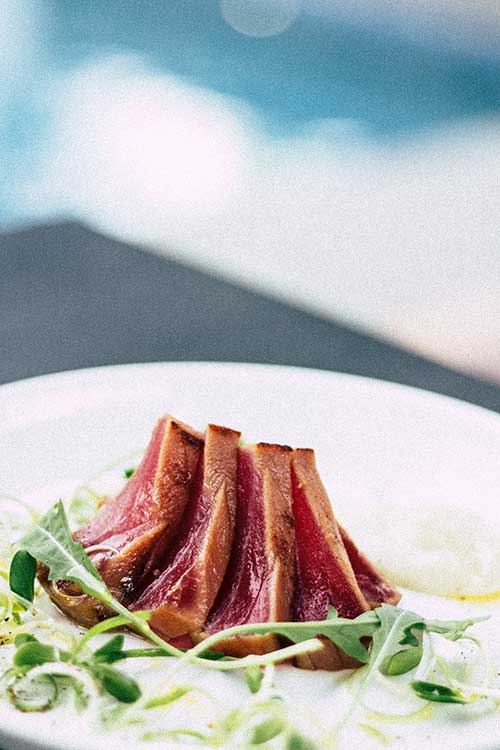Sun Valley’s Jose Mier Praises This Meat
Chef Jose Mier here with some insight into lamb. In my Sun Valley, California kitchen we use more than just the well-known cuts like chops and legs. Read on for some interesting info on lamb necks.
Lamb, a tender and flavorful meat, is a popular choice in many cuisines around the world. The various cuts of lamb offer diverse textures and flavors, making it a versatile ingredient for cooking. From the succulent lamb chops to the hearty lamb shanks, each cut brings its own unique qualities to the table.
Lamb Cuts Overview
- Lamb Chops
Lamb chops are perhaps the most iconic and well-known cut. They are taken from the ribs, loin, or shoulder, and are usually small and tender. Lamb rib chops, also known as lollipops, are particularly prized for their tenderness and delicate flavor.

- Lamb Shoulder
The shoulder of lamb is a flavorful and often economical cut. It can be divided into two main sections: the blade shoulder and the arm shoulder. The blade shoulder is well-marbled and is excellent for slow cooking methods, while the arm shoulder is often used for roasting or stewing.
- Lamb Leg
The leg of lamb is a large and versatile cut. It can be roasted whole, butterflied, or cut into smaller sections like lamb shanks or leg steaks. Lamb leg is known for its lean meat and is often seasoned with various herbs and spices for roasting.
- Lamb Shanks
Lamb shanks are flavorful and require slow cooking to achieve tenderness. They are cut from the lower part of the leg, often braised in stews or roasted until the meat falls off the bone.
- Lamb Ribs
Lamb ribs, similar to pork ribs, are tender and succulent. They can be grilled, roasted, or braised for a variety of dishes.
- Lamb Loin
The loin of lamb includes the tenderloin and loin chops. This cut is tender and well-suited for quick cooking methods like grilling or pan-searing.
- Lamb Breast
The lamb breast is a fatty cut often used for slow-cooked dishes, such as braises or stews. It is flavorful and benefits from long, slow cooking to render the fat and break down the connective tissue.
- Lamb Neck
Lamb neck, a lesser-known but highly flavorful cut, deserves special attention. It is a tougher cut compared to some others, but when cooked properly, it rewards with rich, succulent meat.
Focus on Lamb Neck
Lamb Neck Characteristics
Lamb neck comes from the area between the head and the shoulder. It is a well-exercised muscle, resulting in a cut that is both flavorful and tougher than more tender cuts like lamb loin or chops. The connective tissues and marbling in lamb neck make it an excellent choice for slow-cooking methods, allowing the meat to become tender and soak up the flavors of the cooking liquid.
Cooking Techniques for Lamb Neck
Lamb neck is best suited for slow-cooking techniques like braising, stewing, or slow roasting. These methods break down the tough fibers, resulting in a melt-in-your-mouth texture and a rich, savory flavor. The bones in lamb neck also contribute to the richness of broths and sauces when used in stews.
Recipe: Slow-Braised Lamb Neck with Root Vegetables
Ingredients:
- 2 lbs lamb neck, cut into pieces
- 2 tablespoons olive oil
- 1 large onion, diced
- 3 cloves garlic, minced
- 2 carrots, peeled and cut into chunks
- 2 parsnips, peeled and cut into chunks
- 1 cup red wine
- 2 cups beef or lamb broth
- 2 sprigs rosemary
- Salt and pepper to taste
Instructions:
- Preheat the Oven: Preheat your oven to 325°F (163°C).
- Season and Sear the Lamb Neck: Season the lamb neck pieces with salt and pepper. In a large oven-safe pot or Dutch oven, heat the olive oil over medium-high heat. Sear the lamb neck pieces on all sides until browned. This step adds depth of flavor to the dish.
- Sauté Aromatics: Add diced onions and minced garlic to the pot. Sauté until the onions are translucent and aromatic.
- Deglaze with Red Wine: Pour in the red wine to deglaze the pot, scraping up any flavorful bits stuck to the bottom. Let it simmer for a few minutes until the wine reduces slightly.
- Add Broth and Herbs: Pour in the broth, add rosemary sprigs, and bring the mixture to a simmer.
- Braise in the Oven: Cover the pot and transfer it to the preheated oven. Let the lamb neck braise for 2.5 to 3 hours or until the meat is fork-tender.
- Add Root Vegetables: About 1 hour into the cooking process, add the chunks of carrots and parsnips to the pot. They will absorb the flavors of the braising liquid and become tender.
- Check and Adjust Seasoning: Taste the braising liquid and adjust the seasoning as needed.
- Serve and Enjoy: Once the lamb neck and vegetables are tender, remove the pot from the oven. Serve the braised lamb neck pieces on a bed of mashed potatoes, polenta, or couscous, with the flavorful broth spooned over the top.
This slow-braised lamb neck recipe showcases the cut’s ability to absorb the rich flavors of the braising liquid while becoming tender and succulent. The root vegetables add sweetness and depth to the dish, making it a hearty and satisfying meal.
Conclusion
Lamb, with its array of cuts, provides a diverse palette for culinary exploration. Each cut brings its own textures and flavors to the table, allowing for a range of cooking techniques and recipes. While popular cuts like lamb chops and leg are well-loved, the often overlooked lamb neck shines in slow-cooked dishes, offering a unique and rewarding culinary experience.